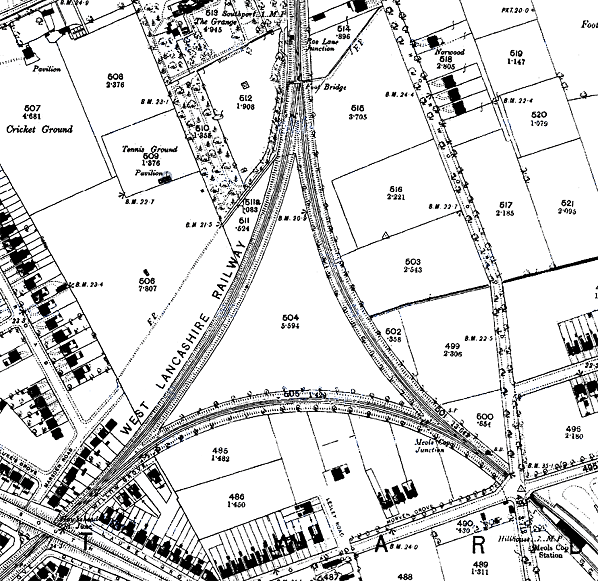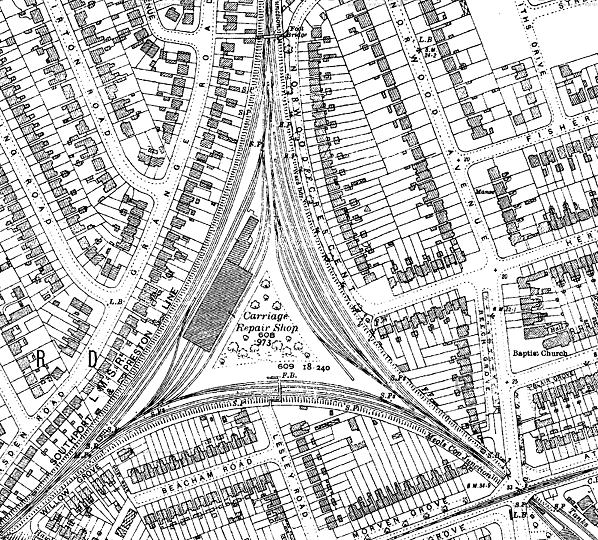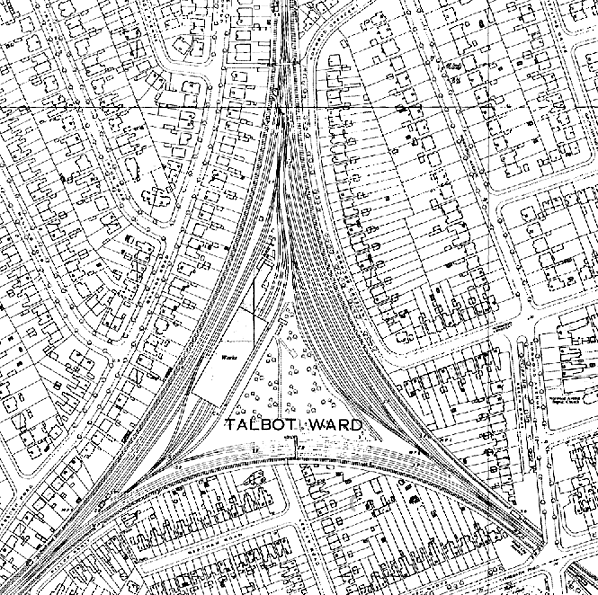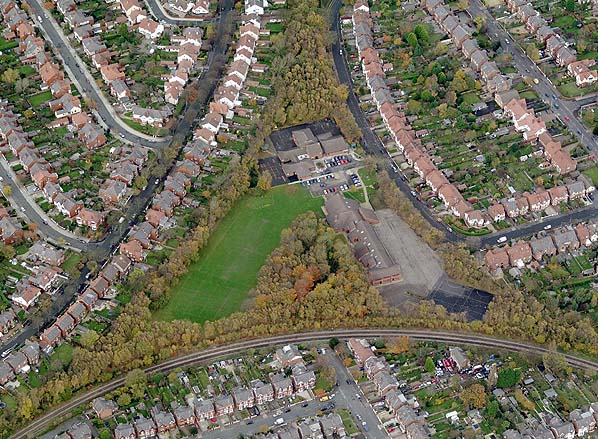
MEOLS COP TRIANGLE & ELECTRIC CAR SHEDS
[Source:Tony Graham & Paul Wright]
The Meols Cop Triangle and the electric car sheds were located on the east side of Southport. The west side of the triangle was the first to open on 10 June 1878. It was part of the West Lancashire Railway’s (WLR) Southport & Preston Railway which opened in a number of stages between 19 February 1878 and 5 September 1882.
The triangle itself was formed when the Liverpool, Southport & Preston Junction Railway (LSPJR) opened the Barton branch on 2 September 1887. The branch had two junctions with the WLR line at Hawkshead Street and at Roe Lane. It split at Meols Cop, the third junction. This layout enabled trains to run directly from the Barton branch both to Southport, via Hawkshead Street Junction, and to Preston, via Roe Lane Junction. The opening of the Barton branch formed the Meols Cop Triangle. The nearest passenger stations to the triangle were St Lukes to the south, Hesketh Park to the north and Meols Cop to the east.
On 1 July 1897 both the WLR and the LSPJR were absorbed into the Lancashire & Yorkshire Railway (LYR). On 5 April 1904 electric services were introduced between Southport Chapel Street and Crossens (on the Preston Line). Initially the western side of the Meols Cop Triangle was electrified, and on 15 February 1909 the other sides were electrified, as was a short section to Meols Cop station.
On 23 December 1912 the LYR opened electric car sheds in the middle of the Meols Cop triangle. The triangle passed to the London & North Western Railway in 1922 and, at the grouping, in 1923 to the London Midland & Scottish Railway. Nationalisation in 1948 saw it transferred to British Railways London Midland Region.
Sources:
See also these stations: St. Lukes, Hesketh Park & Meols Cop
|
The Meols Cop Triangle

The Meols Cop Triangle in 1894 (1:2,500 OS map) when it was still simply the junction between the WLR and the LSPJR. The three junctions are all labelled and Meols Cop station can be seen to the east. The eastern suburbs of Southport had already reached the western side of the triangle and within a few decades would engulf it.

By 1928 (1:2,500 OS map) the Meols Cop Triangle was surrounded by housing developments. The only land available to the LYR for the car sheds had been within the triangle and they can clearly be seen on this map. The woodland in the centre had been planted to mask the shed building from the nearby housing areas.

The Meols Cop triangle in 1961. (1:2,500 OS map) Still with all three sides in use and with the electric car sheds active. Within three years the decline would begin.
ROE LANE JUNCTION
Roe Lane Junction was at the northern point of Meols Cop Triangle. Both the WLR and the LSPJR were double-track, and the junction was scheduled to open on 1 September 1887. On the day that services were due to start the contractor C Braddock removed rails from the LSPJR at Roe Lane Junction as he was in dispute with the railway company. The LSPJR had to obtain an injunction against the contractor so that the line could open on 2 September 1887.
The junction was controlled by a Railway Signal Company box on the west side of the line adjacent to the north end of the junction. It was an all-timber construction with a Railway Signal Company 13-lever frame. Adjacent boxes to Roe Lane Junction were Hesketh Park on the Preston line, Meols Cop on the Barton branch and Hawkshead Street Junction in the Southport direction.
Roe Lane Junction saw passenger and goods services running between Southport and Preston and between Preston and the Barton branch. The WLR operated a service between Liverpool Central and Preston which used the eastern side of the triangle.
When the LYR took over the WLR and LSPJR in 1897 through services between Preston and the Barton branch were reduced, and it appears that the eastern side of the triangle saw little traffic. As at 13 April 1902 the signal box was closed on Sundays and Mondays, and between Tuesday and Friday it was open only between 5:30 and 8:15 am or until the 7:00 am Altcar to Preston WL goods service had passed. On Saturdays the box was open from 7:00 to 10:15 am or until the 9:00 am Altcar to Preston WL goods had passed. The times of opening clearly demonstrate how little the east spur was used. During periods when the box was closed the line between Hawkshead Street Junction and Hesketh Park was switched out, with ‘clear’ signals allowing the normal passage of Southport and Preston services over the western spur of the triangle.
|
junction1.jpg)
Looking south towards the Meols Cop electric car sheds from Roe Lane Junction in 1964. Two ex-LMS EMUs of 1939 had just passed on the eastern spur of the Meols Cop triangle. The one closest to the photographer was heading for Crossens and would shortly cross over Roe Lane Junction. The other was en-route to Southport via Meols Cop station. It would reverse at Meols Cop and then travel along the southern side of the triangle to reach Southport. To the right of the picture is the western side of the triangle that ran from Roe Lane Junction to Hawkshead Street junction.
The introduction of electric services between Southport and Crossens in 1904 (on the western side of the triangle) and the extension of the live rails to Meols Cop in 1909 (using both the eastern and southern sides) made the box much busier: it remained open from first to last train.
In preparation for the opening of the electric car shed on 23 December 1912 alterations were made to the track layout at Roe Lane Junction. To facilitate this layout the box required 26 levers. However it could accommodate only 24, so a new24-lever LYR frame was fitted, along with a further two levers in the rear of the box at right-angles to the rest of the lever frame. Connections into the shed were provided from both the western and eastern spurs of the triangle, both located immediately south of the main line junction.
On 7 September 1964 the Preston line was closed between Hesketh Park and Penwortham Junction (Preston). The western spur of the triangle also closed and was disconnected at Hawkshead Street on 28 September 1964. It remained connected at Roe Lane Junction but became two long sidings serving the electric car sheds.
The signal box continued to be open from 8:00 am to 4:00pm Monday to Friday to facilitate the movement of EMUs to and from the repair shops, via the eastern spur. A daily coal train continued to run past Roe Lane Junction en route to Hesketh Park until Friday 24 November 1967. On Monday 27 November 1967 an engine made a last trip to Hesketh Park to recover wagons.
On 9 June 1968 the line between Roe Lane Junction and Hesketh Park closed. EMUs continued to use the east spur passing a short distance north of the box to Roe Lane bridge, where buffer stops had been erected. On Sunday 23 June 1968 Roe Lane Junction box closed along with the eastern side of the triangle to Meols Cop. However EMUs continued to run through the site of Roe Lane Junction, via a new connection from Meols Cop Junction sidings, directly into the electric car sheds. A short portion of the former WLR down main line survived as a shunting neck as far as Roe Lane bridge. All points formerly controlled by Roe Lane Junction box at the entrance to sheds leading off the shunting neck were converted to hand operation. At the same time the two sidings which were formerly the main line on the western site of the triangle closed and were lifted shortly after. Roe Lane box was still standing derelict in November 1968.
The electric car sheds closed on 14 February 1970, but the track was not disconnected at the Meols Cop Junction end until 12 April 1970. At some later date all track was removed from the site of Roe Lane Junction. |
junction3.jpg)
The northern point of the Meols Cop triangle looking south towards the electric car shed from Roe Lane Junction in July 1965. To the left on the eastern spur of the triangle can be seen the daily coal service that ran between Southport and Hesketh Park (the then limit of the former WLR line) at that time. To the right is the seen the western spur. It had been converted into two dead end sidings and an EMU of 1939 vintage is seen stabled on the former down line. The car shed itself can be seen in the distance. Its position inside the triangle is clearly illustrated by the picture.
Photo
by B. Barlow
MEOLS COP JUNCTION
Meols Cop Junction was the eastern point of the triangle where the LSPJR forked. A spur left northward to join the WLR line at Roe Lane Junction (allowing direct access to Preston) and another led westward to Hawkshead Street Junction (giving direct access via the WLR to Southport). The junction opened to traffic on 2 September 1887.
The lines were double-track, and the junction was controlled by a Railway Signal Company timber signal box containing a 13-lever frame. The box was adjacent to the junction on the north side of the line, just west of Norwood Road overbridge. Beyond the bridge was Meols Cop station.
In the early years Meols Cop Junction was used by LSPJR goods and passenger trains between the Barton branch and Southport and also by through services to Preston, including a WLR passenger service between Preston and Liverpool Central. After the LYR had taken over in 1897 there were far fewer through trains between Preston and the Barton branch, and the eastern side of the triangle was little used.
On 15 February 1909 electric services began to operate over the junction. Live rails had been laid between Hawkshead Street Junction and Meols Cop station and between Meols Cop Junction and Roe Lane Junction. The works were an addition to the 1904 electrification of the line between Southport and Crossens. From 1909 many Crossens services ran via Meols Cop station where they reversed to go onward to Crossens or Southport.
On 13 February 1911 the LYR opened a line to the east of Meols Cop to connect the Barton branch with the Southport and Wigan line. This gave an alternative route into and out of Southport for trains using that line; Meols Cop Junction saw extra traffic as a result. At the same time the frame at Meols Cop Junction box was extended to 21 levers. This was a temporary arrangement to facilitate the building of electric car sheds within the triangle.
As with the other junctions on the triangle alterations were made at Meols Cop Junction for the opening of the electric car sheds which opened on 23 December 1912. The signal box was doubled in size, being extended towards Southport. A new LYR 36-lever frame was installed. A connection was made a short distance north-east of the junction from the eastern spur into sidings that served the car sheds (where EMUs were stabled) but were not physically connected to the shed itself. A crossover was also provided at the actual junction.
On 27 November 1967 the last service to travel north of Roe Lane Junction, a coal train for Hesketh Park, passed over the eastern side of the triangle. As EMUs still needed to reach the car sheds via the eastern spur, alterations were made. On 23 June 1968 the eastern spur was closed. At Meols Cop the facing junction to Roe Lane was removed, and the trailing junction was altered to access a single remaining siding which in turn had been altered to connect to the Meols Cop electric car sheds. Electric trains then reached the sheds via the new arrangements. However the situation did not last long as the sheds closed on 14 February 1970. The connection from Meols Cop Junction was removed on 12 April 1970. The following week the live rails were removed all the way back to Southport. Meols Cop ceased to be a junction. On 24 September 1972 Meols Cop Junction box closed. The line that formed the southern side of the triangle remains open |
junction1.jpg)
Meols Cop Junction which formed the eastern point of the Meols Cop Triangle as seen looking north-west in 1949 from Tithebarn Road bridge. The picture was taken from the Norwood Avenue bridge and shows the arrangement of lines as they had been since 1912. The main line going off to the left was the route to Hawkshead Street Junction on onward to Southport. It formed the base of the triangle. The line veering off to the right is the eastern spur that ran to Roe Lane Junction and provided a direct route towards Preston. Within the triangle can be seen numerous sidings which served the electric car sheds.
Copyright photo from Stations UK
HAWKSHEAD STREET JUNCTION
Hawkshead Street Junction was at the south-western corner of the triangle. Both the WLR and LSPJR were double-track lines, and the junction was scheduled to open on 1 September 1887. On the day that services were due to start the contractor C Braddock removed rails from the LSPJR at Hawkshead Street Junction as he was in dispute with the railway company. The LSPJR had to obtain an injunction against the contractor so that the line could open on 2 September 1887.
The junction was controlled by a Railway Signal Company box on the west side of the line, adjacent to the points that formed the junction. The box was an all-timber structure containing a Railway Signal Company 13-lever frame. Adjacent boxes to Hawkshead Street Junction were Meols Cop, on the Barton Branch; Roe Lane Junction on the Preston line; and Ash Street (from 1902 known as St Lukes Road and, from 1918, St Lukes) on the route to Southport.
After the LSPJR line had opened, Hawkshead Street Junction was used by passenger and goods trains between Southport and Preston, also between Southport and Hillhouse via Barton.
In 1900 the original signal box closed and was replaced with an LYR box in the fork of the junction. It had a brick base and timber upper section. At first it had a 20-lever LYR frame. The original box was not demolished but was altered for use as a platelayers’ hut.
|
Looking east in October 1964 as a class 108 Derby Built DMU passe over Hawkshead Street Junction on its way into Southport from the Wigan line. Veering off to the left is the former WLR Preston line which had closed on7 September 1964. Close inspection shows its rails to be rusty. In the fork of the junction the LYR Hawkshead Junction Signal box can be seen. Its predecessor from 1887 was still standing in use as a plate layers hut and can be seen to the left of the DMU. Beyond the LYR box is the Meols Cop electric car sheds.
Photo
by B. Barlow
The introduction of electric services made Hawkshead Street much busier. By 1909 electrics ran between Hawkshead Street Junction and Meols Cop Junction and also Roe Lane Junction. Some electric services ran directly between Crossens and Southport, using the western side of the triangle, but most ran via Meols Cop station where they reversed. These services used the south and east sides of the triangle.
In preparation for the opening of the electric car sheds on 23 December 1912 alterations were made at Hawkshead Street. The signal box frame was enhanced to 32 levers. Just beyond the junction, on the Meols Cop line, a set of points was installed that led into the car sheds. A crossover was also installed at the junction so that traffic coming out of the shed could run ‘right-line’ to Southport.
On 7 September 1964 the former WLR line to Preston closed as a through route. A section extending to Hesketh Park remained open for a daily coal train, but the western side of the Meols Cop Triangle closed with effect from 28th of September 1964. The junction towards Preston was disconnected on 28 September 1964. Hawkshead Street box closed 11 October 1965. Following its closure various track alterations took place which included conversion of the former western side of the triangle into sidings accessed from Roe Lane Junction. Buffer stops were placed on each of the lines just north of the junction’s site. The access points to the car sheds were also removed and, to facilitate shunting operations, one of the shed shunting necks was extended through the site of the signal box. The line to Meols Cop became a basic double-track railway. The original box, which had been converted into a platelayers’ hut, was still standing in March 1967.
|
junction1.jpg)
The Meols Cop electric car sheds looking northeast from Hawkshead Street Junction in 1964.
MEOLS COP ELECTRIC CAR SHEDS
By October 1911 the LYR had a substantial network of electric lines that radiated from Liverpool Exchange and extended northward to Crossens (via Southport) and Town Green on the Liverpool to Preston (via Ormskirk) line. Day-to- day repairs to the electric rolling stock were carried out at the former East Lancashire Railway Company’s Southport ( London Street) station which had been electrified in 1905 and fitted out as a carriage shed with cranes and machinery. For more major works the rolling stock had to be towed to Newton Heath in Manchester. The situation was not ideal, and, with further extensions to the electric system planned, a better arrangement was required.
The land in the centre of the Meols Cop Triangle was considered to be ideal. All sides of the triangle had been electrified by 15 February 1909, and the LYR owned the land. Approval for the construction of electric car sheds was given on 15 December 1910, and the cost was estimated at £30,976.30s. Sidings were laid in 1911, and a contract for the construction of a shed building was let to E Taylor & Son for £11,483 on 20 June 1912. The car sheds were opened only six months later on 23 December 1912.
The sheds consisted of a large brick building adjacent to the western side of the triangle (the Hawkshead Street to Roe Lane Junction line). It had large windows along the sides and skylights in the roof. At its southern end it had five access doors all served by sidings, three of which were dead-end inside the shed whilst two exited at the northern end. At some stage the door at the southern end on the western side was bricked-up. There was also a boiler-house and stores area that extended beyond the main building towards the north.
Inside the shed was light and roomy, and it was fitted out with all of the machinery and lifting equipment required for the maintenance of the electric train sets. There were also service pits.
To the west of the shed were two sidings located between it and the main line on the western side of the triangle. They were connected to the shed at both ends. To the east of the shed were sidings used for the storage of stock, but there was no physical connection from them to the shed until 23 June 1968. To the south there were lines that aided shunting movements.
|
shed1.jpg) Looking north towards the Meols Cop Electric Car Shed in the 1950s
Looking north towards the Meols Cop Electric Car Shed in the 1950s
At the time of opening the electric car sheds were responsible for the maintenance and repair of 38 motor cars and 53 trailers that had been introduced from 1904 and which formed 50 individual train sets. There were also two baggage cars that operated independently. They were multiple unit trains, the electrical equipment built and supplied by Dick Kerr and the bodies built by the LYR at Horwich and Newton Heath. There were also eleven cars built to facilitate a service from the LYR system onto the Liverpool Overhead Railway. Additional cars had also come into use in 1911.
In 1927, during the LMS era, new rolling stock in the form of eleven three-car compartment stock EMUs was introduced and also became the responsibility of Meols Cop.
In August 1939 the first of what would become a fleet of 34 three-car and 25 two-car EMUs (later under BR to become class 502) arrived at Meols Cop from Derby. The new sets were revolutionary, with wide bodies and automatic sliding doors. They would remain in service as passenger trains until October 1980 and were the last class of EMU serviced by Meols Cop shed.
EMUs from other systems including the Lancaster and Morecombe overhead network also came to Meols Cop for attention. They also returned upon their withdrawal in 1966 for breaking up.
The Re-Shaping of Britain’s Railways report of 1963 recommended the complete abandonment of the former LYR electric network radiating from Liverpool Exchange, including complete closure of the Liverpool and Southport line, and beyond to Crossens. There was an outcry over the proposal and, in the end, only the service between Southport and Crossens was axed.
The electric car sheds continued to service the class 502 EMUs until 14 February 1970 after which they were closed and demolished. The site of the shed building had become wooded by July 2011, and the eastern storage sidings had been developed as a school. |
shed2.jpg)
Looking south inside the Meols Cop Electric Car Shed in the LMS era probably just after the Second World War. The scale of the shed and its capabilities are clearly demonstrated
junction6.jpg)
Looking south towards the Meols Cop electric car sheds from the site of Roe Lane Junction in c1969. Both the western and eastern spurs of the Meols Cop triangle had been lifted. All that remained was an access line that ran up from Meols Cop Junction, through the site of the former eastern sidings, to Roe Lane Junction where it continued along the former WLR Preston line for a short distance. The access provided access into the shed. Five years earlier the view would have been of a very busy railway junction and repair facility
Click here for more pictures of the Meols Cop Triangle
| Last
updated: Thursday, 18-May-2017 17:21:46 CEST |
© 1998-2012 Disused Stations
| |



junction1.jpg)
junction3.jpg)
junction1.jpg)
junction2.jpg)
junction1.jpg)
shed1.jpg)
shed2.jpg)
junction6.jpg)
junction4.jpg)
junction4.jpg)
junction9.jpg)



 Home Page
Home Page